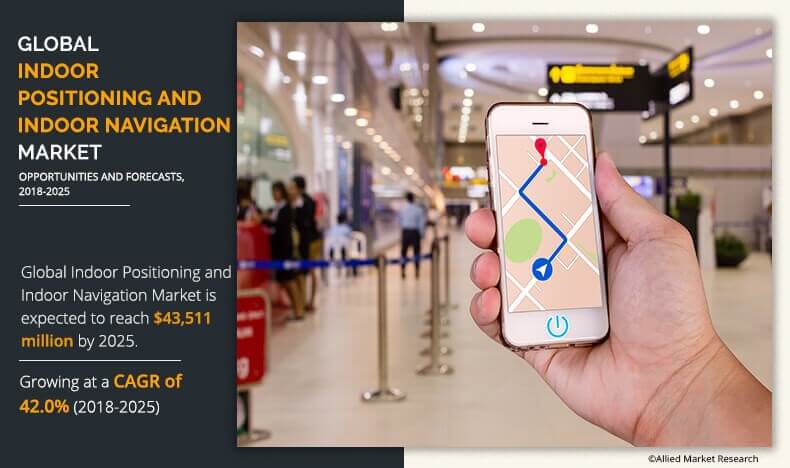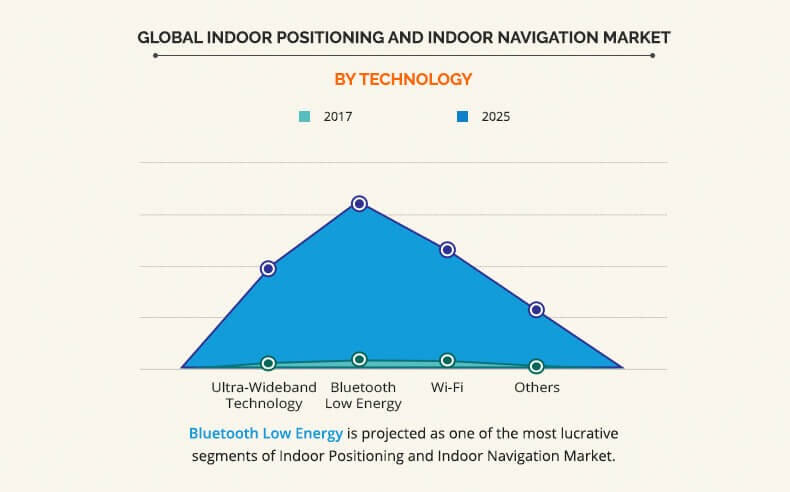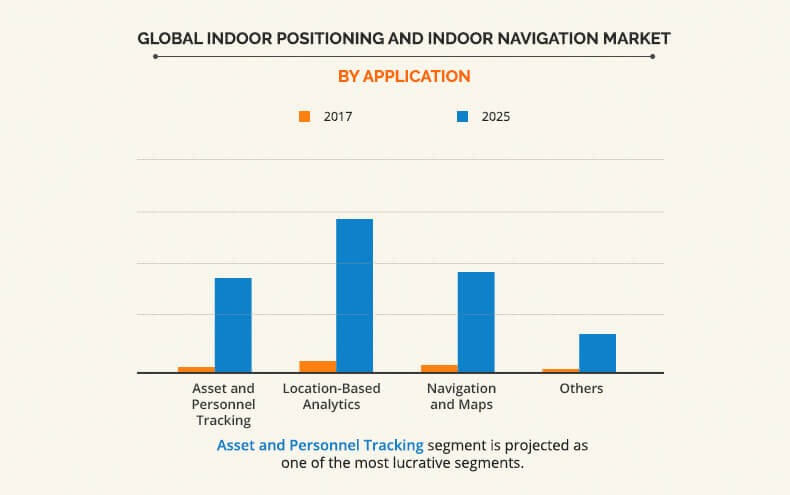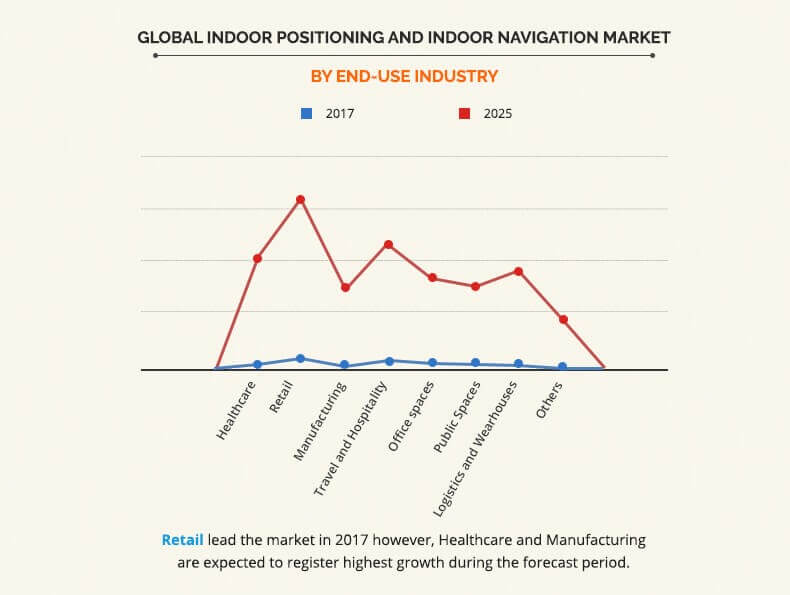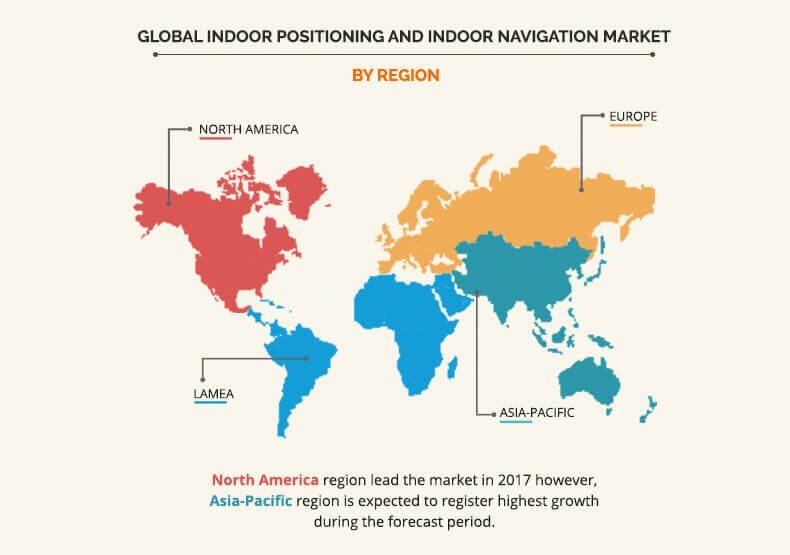Indoor Positioning and Indoor Navigation (IPIN) Market Outlook: 2025
The global indoor positioning and indoor navigation market was valued at $2,642 million in 2017, and is projected to reach $43,511 million by 2025, growing at a CAGR of 42.0% from 2018 to 2025. Indoor positioning and indoor navigation (IPIN) is a system that provides a central platform to detect or track the geographical location of asset and personnel through the deployment of wireless technologies, such as Bluetooth low energy, Wi-Fi, ultra-wideband, and others. It offers location analytics, navigation, mapping, wayfinding, asset tracking, and other solutions to its end-users.
In addition, it provides better connectivity, effective and quick access to precise location, indoor location-based services to deliver proximity marketing, workflow optimization through asset and personnel tracking, and enhanced indoor navigation and routing, which are expected to drive the growth of the global indoor positioning and indoor navigation market. Furthermore, rise in demand for the IPIN devices and solutions among various venues such as shopping malls, airports, hotels, university buildings, warehouses, hospitals, and other areas is anticipated to provide lucrative growth opportunities for the global market during the forecast period.
The location-based analytics segment dominated the overall indoor positioning and indoor navigation market share in 2017 and is expected to continue this trend during the forecast period due to increase in demand from retail industry, as it allows end users to understand customers in real-time and send relevant messages related to their identity and needs. In addition, the asset and personnel tracking segment is also expected to grow at a rapid pace during the forecasted period.
The retail segment dominated the overall indoor positioning and indoor navigation market in 2017 and is expected to continue this trend during the forecast period due to numerous benefits of IPIN solutions in retail industry such as improved customer searches, effective route planning, and optimized customer targeting.
North America dominated the overall market in 2017, as the U.S. is a major contributor to the indoor positioning and indoor navigation market growth in this region. The dominance of this region is primarily due to the availability of advanced connectivity wireless technology and indoor technologies among retail, travel, hospitality, healthcare, and public spaces. In addition, Asia-Pacific is expected to witness the highest growth rate during the forecast period due to rise in penetration of indoor Location-Based Services (LBS), connected devices, and Real-Time Location Systems (RTLS) market among India and China.
The report focuses on the growth prospects, restraints, and trends of global indoor positioning and indoor navigation market. The study provides Porters five forces analysis of the IPIN industry to understand the impact of various factors such as bargaining power of suppliers, competitive intensity of competitors, threat of new entrants, threat of substitutes, and bargaining power of buyers on the indoor positioning and indoor navigation market growth.
Segment Review
The global indoor positioning and indoor navigation market is segmented based on component, technology application, end-use industry, and region. In terms of component, the market is categorized into software, hardware, and services. Based on technology, it is divided into ultra-wideband technology, Bluetooth low energy, Wi-Fi, and others.
In terms of application, the market is segmented into asset & personnel tracking, location-based analytics, navigation & maps, and others. On the basis of end-use industry, the market is segmented into healthcare, retail, manufacturing, travel & hospitality, office spaces, public spaces, logistics & warehouses, and others.
The key players operating in the global indoor positioning and indoor navigation market analysis include HERE Technologies, Nextome, IndoorAtlas, Senion AB, Sensewhere, SPREO, Steerpath, indoo.rs, Pointr, and AirFinder.
Top Impacting Factors
The factors such as rise in adoption of Bluetooth beacons, increase in demand for proximity marketing, and surge in adoption of IoT in indoor positioning are expected to drive the market growth. However, operational challenges are expected to hamper the global indoor positioning and indoor navigation market growth during the forecast period. Furthermore, IPIN systems in the healthcare sector are expected to provide lucrative opportunities for the growth of the global indoor positioning and indoor navigation market.
Rising adoption of Bluetooth Beacons
Beacon infrastructure plays a significant role in generating the contextual and hyper-local data that is vital for retail industry. Retailers or wholesalers can engage customers through highly relevant content for shopping, based on their exact location and accumulation of relevant data for marketing as well as streamlining operations. In addition, the factors such as its low deployment cost and high applicability in a wide range of mobile devices are expected to drive the growth of indoor positioning and indoor navigation market. Also, beacons are easy to deploy and have reasonable features due to which their adoption rate has significantly increased over the years.
Increase in demand for proximity marketing
Increase in awareness of proximity marketing is witnessed in the retail sector due to the advancement of promotional strategies followed by major key players in the retail sector. Beacon technology provides a new micro-location level of promotion to reach the target audience where proximity is key. Through promotional offers and notifications, dealers and store owners intend to keep shoppers engaged every time, which in turn results in higher sales. In addition, the major strength of proximity marketing is its ability to deliver the right message to the right user at the right time, which is the major factor driving the growth of the indoor positioning and indoor navigation market. Also, such contextual approach of proximity marketing has made it 16 times more effective than Google Ads. Moreover, among all other industry verticals which have invested in proximity marketing, the retail industry is witnessing the rapid adoption, which is expected to provide lucrative opportunities for the growth of the IPIN market.
Key Benefits for Indoor Positioning and Indoor Navigation (IPIN) Market:
- This study presents the analytical depiction of the global indoor positioning and indoor navigation market trends and future estimations to determine the imminent investment pockets.
- The report presents information related to key drivers, restraints, and opportunities.
- The current indoor positioning and indoor navigation market size is quantitatively analyzed from 2017 to 2025 to highlight the financial competency of the industry.
- Porters five forces analysis illustrates the potency of buyers & suppliers in the global indoor positioning and indoor navigation industry.
Indoor Positioning and Indoor Navigation (IPIN) Market Report Highlights
| Aspects | Details |
| By Component |
|
| By Technology |
|
| By Application |
|
| By End Use Industry |
|
| By Region |
|
| Key Market Players | STEERPATH, Sensewhere, POINTR, IndoorAtlas, Nextome, INDOO.RS, HERE Technologies, AIRFINDER, SPREO, Senion AB |
Analyst Review
Indoor Positioning and Indoor Navigation (IPIN) provides a central platform to detect and track the geographical position of people and assets using various technologies such as Bluetooth low energy, Wi-Fi, ultra-wideband, and others. Implementation of IPIN enables end users to use this technology for proximity marketing, physical security, workflow optimization, patient tracking, and other important applications. Therefore, IPIN is majorly being adopted as a mainstream technology across shopping malls & supermarkets, hotels, metro & train stations, airports, stadiums, museums, warehouses, and others. In addition, rise in demand for Bluetooth beacons; increase in need for proximity marketing; massive growth of indoor Location-Based Services (LBS), connected devices, and Real-Time Location Systems (RTLS) are some of the factors that are expected to offer lucrative opportunities for the indoor positioning and indoor navigation market growth during the forecast period. Moreover, adoption of indoor positioning and indoor navigation market has increased over the past few years due to factors such as increasing IoT penetration in location tracking, increase in need for initiatives such as industry 4.0 and logistics 4.0 among manufacturing & logistics industry. Also, rapid proliferation of business analytics solutions and cloud technology is also expected to provide great opportunities for indoor positioning and indoor navigation market as they can be integrated into the systems to get the relevant data of customer’s preference and enhance the business operations.
Some of the key players operating in the global indoor positioning and indoor navigation market include HERE Technologies, Nextome, IndoorAtlas, Senion AB, Sensewhere, SPREO, Steerpath, indoo.rs, Pointr, and AirFinder. The key players have adopted various growth strategies to enhance their product portfolio, to strengthen their indoor positioning and indoor navigation market share, and to increase their market penetration. For instance, in June 2018, HERE Technologies and Decawave announced strategic partnership to offer their products in collaboration to deliver improved and energy-efficient tracking solution for their customers. Also, in June 2017, LogicJunction and IndoorAtlas partnered to offer enhanced indoor positioning solutions for the healthcare industry.
Loading Table Of Content...

